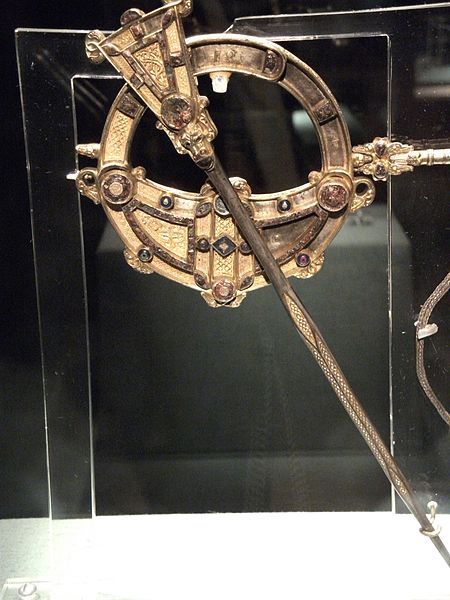The Tara Brooch: Gold and Jewels from the Ancient Irish Past
The Tara Brooch is justifiably among the most celebrated of all works of Celtic art. Dating to the early eighth century, the “Golden Age” of Celtic Irish history, this brooch has been called “The Book of Kells of Irish jewelry”.1 It is one of the most elaborate and intricate surviving examples of the famous Celtic metalwork practice, and its style and decoration are rich in Celtic history and artistic tradition.
In ancient Celtic culture, brooches served both the practical function of holding one’s shawl closed, and the social function of indicating one’s wealth and status. In fact, the relationship between brooches and social standing, which may have originated during the Roman period, was so strong that laws were established to govern the richness of brooches permitted to various ranks of nobility.2 Although the Tara Brooch’s elaborate design and rich materials cater to the romantic notion that it was once worn by a royal or other high-ranking noble, the identity of its original owner is unclear. Brooches were also made and worn by the clergy, and cruciform shapes and other types of Christian symbolism have been read into many Celtic brooches including the Tara Brooch.3 One of the most common types of brooch was the “penannular” brooch, which took the shape of a broken circle with large and highly-decorated terminals. The Tara Brooch is of a popular subset known as “pseudo-penannular” brooches, meaning that it has the general appearance of a penannular brooch with decorative, terminal-like elements, but is in fact a complete circle.

The Tara Brooch is made of gold, silver, copper, amber, and colored glass. Both the front and back are fully decorated across every surface with a very high degree of detail. Much of the decoration is interlace, often involving animal forms. This interlace was created using several techniques, including filigree, chip carving, granulation, and a traditional type of embossing. The brooch also includes three-dimensional metal animal heads and inlaid pieces of amber and coloured glass in a variety of shapes.4
Interlace was a highly prominent motif in the Celtic artistic tradition and is thought to bear much symbolic significance, particularly when it involves zoomorphic (animal) elements. Such symbolism stemmed from pre-Christian traditions but also developed Christian significance. In Ireland and elsewhere, interlace has been thought to possess apotropaic qualities, meaning that it has the power to protect against evil.5 It frequently appears in Celtic metalwork, sculpture (such as stone High Crosses), and illuminated manuscripts. It is probably the most universally recognized aspect of Celtic Irish art, particularly in the form of the “Celtic knot”, and is commonly featured in pseudo-Irish logos, jewelry, and other souvenirs. Interlace covers almost the entire surface area of the Tara Brooch and many other Celtic works of art, suggesting a cultural fear of empty spaces (horror vacui) that would have compelled artists to fill every inch of available space on even the smallest objects with intricate patterning.6
Recent interpretations of similar medieval Celtic objects suggests that the bird and animal forms within the interlace and on the borders of the Tara Brooch may have carried additional religious symbolism. The famous Book of Kells is profusely decorated with zoomorphic interlace, which has been suggested to have had complex Christian meanings now largely faded from cultural memory.Significant pieces of Celtic metalwork with related animal and interlace decoration, including the Hunterston Brooch and the Ardagh Chalice, are thought to have also held symbolic meanings variously straightforward and obscure.7
The title “Tara Brooch” is a modern rather than ancient or traditional name, and like many modern nicknames for historical works of art, it is not quite accurate. While its precise place of creation is unknown, the Tara Brooch was discovered in the nineteenth-century in a hoard buried in the Irish town of Bettystown. It has no connection to Tara except for the fact that both Tara and Bettystown are located in County Meath, Ireland. The Hill of Tara was an important ancient Celtic ceremonial site, so this regal-looking brooch was given the name of this once-royal place to enhance its intrigue.8 Regardless of its name, however, the beauty of the object, with its intricate details and sumptuous materials, speaks for itself and the artistic tradition from which it came.
The Tara Brooch is owned by and on display at the National Museum of Ireland in Dublin.
Notes: (1) Harbinson, Peter. Ireland’s Treasures: 5000 Years of Artistic Expression. Hugh Lauter Levin Associates, Inc, 2004. 74 (caption). (2) Laing, Lloyd and Jennifer Laing. Celtic Britain and Ireland Art and Society. New York: St. Martin’s Press, 1995. 96-97. (3) Harbinson. Ireland’s Treasures. 75. (4) Laing and Laing. Celtic Britain and Ireland. 157-158. (5) Ibid. 209, 215-216. (6) Harbinson. Ireland’s Treasures. 76. (7) Laing, Lloyd and Jennifer Laing. Art of the Celts. London: Thames & Hudson Ltd., 2000. 146-148, 160-162. Laing and Laing. Celtic Britain and Ireland. 215-216. (8) Harbinson. Ireland’s Treasures. 75 (caption).
